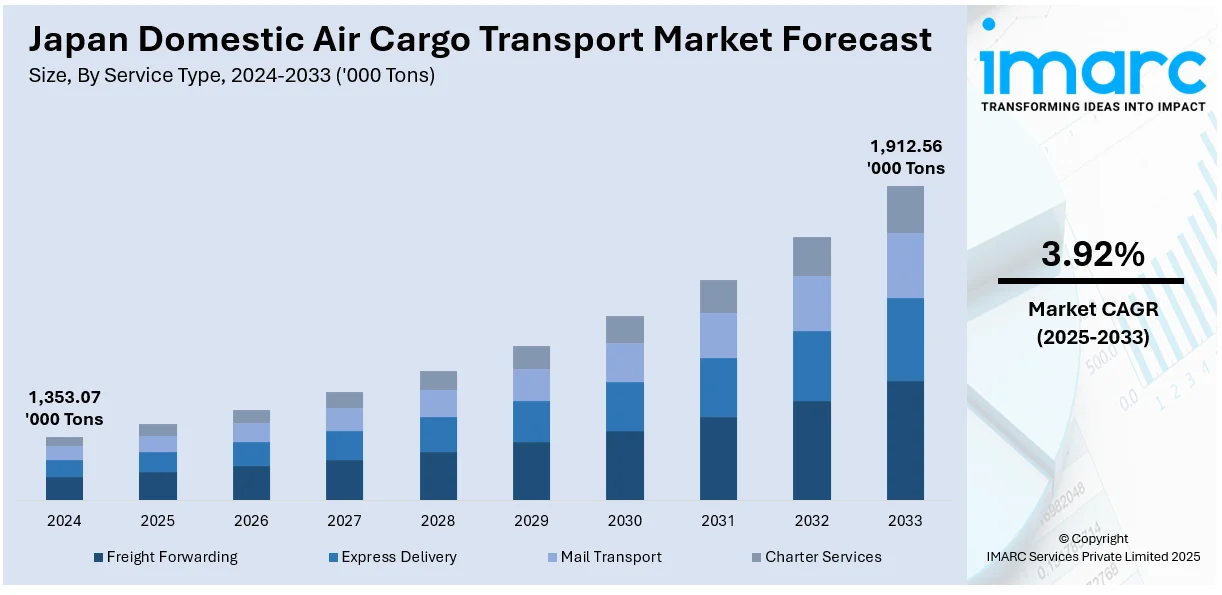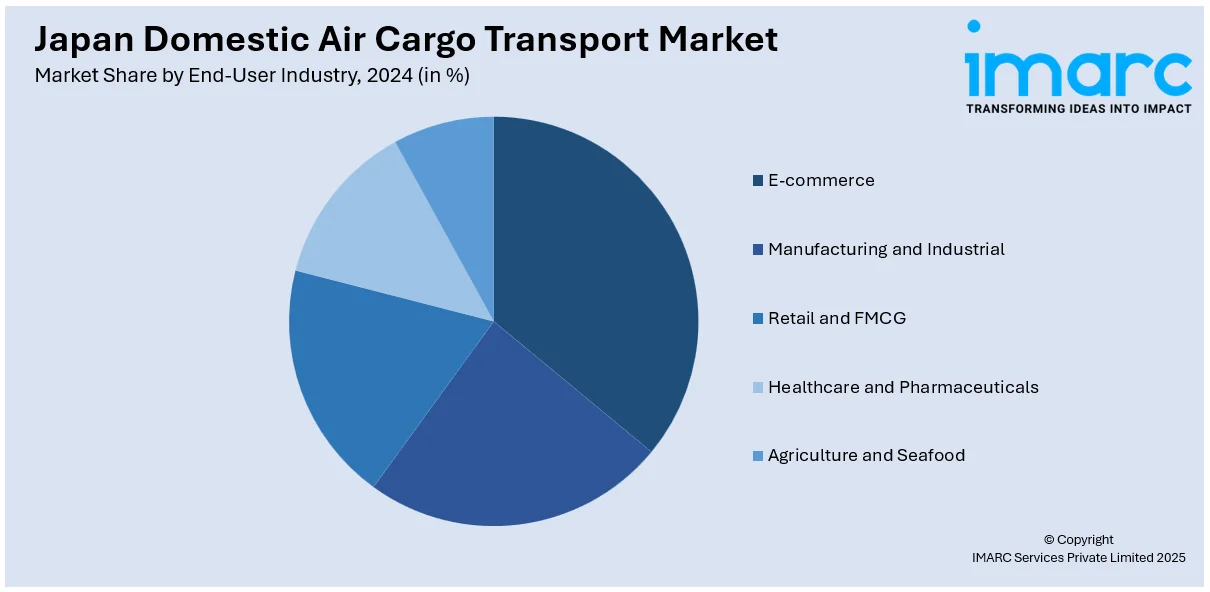
Japan Domestic Air Cargo Transport Market Size, Share, Trends and Forecast by Service Type, Cargo Type, Aircraft Type, End-User Industry, and Region, 2025-2033
Japan Domestic Air Cargo Transport Market Overview:
The Japan domestic air cargo transport market size reached 1,353.07 Thousand Metric Tons in 2024. Looking forward, IMARC Group expects the market to reach 1,912.56 Thousand Metric Tons by 2033, exhibiting a growth rate (CAGR) of 3.92% during 2025-2033. The market is witnessing consistent growth as driven by increasing demand for efficient logistics and timely delivery. Focused on developing transport infrastructure and technology, the Japan domestic air cargo transport market share is anticipated to grow, enhancing service delivery and operational efficiency.
|
Report Attribute
|
Key Statistics
|
|---|---|
|
Base Year
|
2024
|
|
Forecast Years
|
2025-2033
|
|
Historical Years
|
2019-2024
|
| Market Size in 2024 | 1,353.07 Thousand Metric Tons |
| Market Forecast in 2033 | 1,912.56 Thousand Metric Tons |
| Market Growth Rate 2025-2033 | 3.92% |
Japan Domestic Air Cargo Transport Market Trends:
Advancements in Technology for Efficiency
Technological innovation is influencing the market in Japan as innovations in tracking, cargo management, and data analytics increase operational efficiency. Moreover, these advances in cargo visibility and management streamline logistics processes, decrease delays, and increase customer satisfaction. Automated cargo handling systems have been adopted by Japan, which allow faster processing times, reduce human error, and increase overall productivity. Besides, the use of artificial intelligence (AI) and machine learning in air cargo operations allows predictive analytics for better delivery timelines and flight routing optimization. This helps reduce costs and enhance operational agility, giving companies better control of their supply chain. All these technological advances are key in addressing the increased demand for e-commerce and express delivery service in Japan. With these solutions deployed on a wider scale, the Japanese market expansion will witness an appreciable boost in service capacity and efficiency, thereby enabling air cargo operators to better respond to market demand.

Rising E-Commerce Demands Driving Growth
Increased e-commerce activity is a primary force behind the Japan domestic air cargo transport market. In addition, compelling logistics companies to reinvent air cargo offerings with online buying growing increasingly popular, the need for quicker delivery services has gained momentum. Also, air cargo is emerging as a prime means of moving merchandise between domestic areas with quick, dependable delivery requirements from e-commerce companies growing. To address the increasing demands of the industry, air cargo operators are making investments in increased fleet capacities and improving air traffic management systems. Besides, collaborations between e-commerce leaders and air cargo companies are increasing, further joining logistics networks to facilitate on-time deliveries. This trend, which is driven by the major development of e-commerce, directly into the Japan domestic air cargo transport market growth because it creates the demand for quick and efficient methods for transporting cargo. In addition to this, Japan's geographical position is strategic. It places the country well as a hub for domestic air cargo transport, with the best flight routes that accommodate growing shipping needs.
Japan Domestic Air Cargo Transport Market Segmentation:
IMARC Group provides an analysis of the key trends in each segment of the market, along with forecasts at the country and regional level for 2025-2033. Our report has categorized the market based on service type, cargo type, aircraft type, and end-user industry.
Service Type Insights:
- Freight Forwarding
- Express Delivery
- Mail Transport
- Charter Services
The report has provided a detailed breakup and analysis of the market based on the service type. This includes freight forwarding, express delivery, mail transport, and charter services.
Cargo Type Insights:
- General Cargo
- Perishable Goods
- Pharmaceuticals and Healthcare Products
- Electronics and High-Value Goods
- E-commerce Shipments
- Automotive Parts and Machinery
A detailed breakup and analysis of the market based on the cargo type have also been provided in the report. This includes general cargo, perishable goods, pharmaceuticals and healthcare products, electronics and high-value goods, e-commerce shipments, and automotive parts and machinery.
Aircraft Type Insights:
- Dedicated Freighters
- Passenger Belly Cargo
- UAVs (Drones)
The report has provided a detailed breakup and analysis of the market based on the aircraft type. This includes dedicated freighters, passenger belly cargo, and UAVs (drones).
End-User Industry Insights:

- E-commerce
- Manufacturing and Industrial
- Retail and FMCG
- Healthcare and Pharmaceuticals
- Agriculture and Seafood
A detailed breakup and analysis of the market based on the end-user industry have also been provided in the report. This includes e-commerce, manufacturing and industrial, retail and FMCG, healthcare and pharmaceuticals, and agriculture and seafood.
Regional Insights:
- Kanto Region
- Kansai/Kinki Region
- Central/ Chubu Region
- Kyushu-Okinawa Region
- Tohoku Region
- Chugoku Region
- Hokkaido Region
- Shikoku Region
The report has also provided a comprehensive analysis of all the major regional markets, which include Kanto Region, Kansai/Kinki Region, Central/ Chubu Region, Kyushu-Okinawa Region, Tohoku Region, Chugoku Region, Hokkaido Region, and Shikoku Region.
Competitive Landscape:
The market research report has also provided a comprehensive analysis of the competitive landscape. Competitive analysis such as market structure, key player positioning, top winning strategies, competitive dashboard, and company evaluation quadrant has been covered in the report. Also, detailed profiles of all major companies have been provided.
Japan Domestic Air Cargo Transport Market News:
- January 2025: Sojitz, BETA, Yamato HD, and the City of Kitakyushu began joint verification tests of electric aircraft for air cargo at Kitakyushu Airport. This initiative, aimed at reducing carbon emissions and enhancing regional logistics, is set to revolutionize Japan’s domestic air cargo transport market by introducing sustainable, efficient transport solutions.
- December 2024: Qatar Airways Cargo and Japan Airlines signed an MoU to strengthen their partnership, enhancing connectivity between Japan and Qatar. This collaboration improved cargo transfer efficiency and expanded network reach, significantly boosting Japan’s domestic air cargo transport market and trade flow.
Japan Domestic Air Cargo Transport Market Report Coverage:
| Report Features | Details |
|---|---|
| Base Year of the Analysis | 2024 |
| Historical Period | 2019-2024 |
| Forecast Period | 2025-2033 |
| Units | Thousand Metric Tons |
| Scope of the Report |
Exploration of Historical Trends and Market Outlook, Industry Catalysts and Challenges, Segment-Wise Historical and Future Market Assessment:
|
| Service Types Covered | Freight Forwarding, Express Delivery, Mail Transport, Charter Services |
| Cargo Types Covered | General Cargo, Perishable Goods, Pharmaceuticals and Healthcare Products, Electronics and High-Value Goods, E-commerce Shipments, Automotive Parts and Machinery |
| Aircraft Types Covered | Dedicated Freighters, Passenger Belly Cargo, UAVs (Drones) |
| End-User Industries Covered | E-commerce, Manufacturing and Industrial, Retail and FMCG, Healthcare and Pharmaceuticals, Agriculture and Seafood |
| Regions Covered | Kanto Region, Kansai/Kinki Region, Central/ Chubu Region, Kyushu-Okinawa Region, Tohoku Region, Chugoku Region, Hokkaido Region, Shikoku Region |
| Customization Scope | 10% Free Customization |
| Post-Sale Analyst Support | 10-12 Weeks |
| Delivery Format | PDF and Excel through Email (We can also provide the editable version of the report in PPT/Word format on special request) |
Key Questions Answered in This Report:
- How has the Japan domestic air cargo transport market performed so far and how will it perform in the coming years?
- What is the breakup of the Japan domestic air cargo transport market on the basis of service type?
- What is the breakup of the Japan domestic air cargo transport market on the basis of cargo type?
- What is the breakup of the Japan domestic air cargo transport market on the basis of aircraft type?
- What is the breakup of the Japan domestic air cargo transport market on the basis of end-user industry?
- What is the breakup of the Japan domestic air cargo transport market on the basis of region?
- What are the various stages in the value chain of the Japan domestic air cargo transport market?
- What are the key driving factors and challenges in the Japan domestic air cargo transport market?
- What is the structure of the Japan domestic air cargo transport market and who are the key players?
- What is the degree of competition in the Japan domestic air cargo transport market?
Key Benefits for Stakeholders:
- IMARC’s industry report offers a comprehensive quantitative analysis of various market segments, historical and current market trends, market forecasts, and dynamics of the Japan domestic air cargo transport market from 2019-2033.
- The research report provides the latest information on the market drivers, challenges, and opportunities in the Japan domestic air cargo transport market.
- Porter's five forces analysis assist stakeholders in assessing the impact of new entrants, competitive rivalry, supplier power, buyer power, and the threat of substitution. It helps stakeholders to analyze the level of competition within the Japan domestic air cargo transport industry and its attractiveness.
- Competitive landscape allows stakeholders to understand their competitive environment and provides an insight into the current positions of key players in the market.
Need more help?
- Speak to our experienced analysts for insights on the current market scenarios.
- Include additional segments and countries to customize the report as per your requirement.
- Gain an unparalleled competitive advantage in your domain by understanding how to utilize the report and positively impacting your operations and revenue.
- For further assistance, please connect with our analysts.
 Request Customization
Request Customization
 Speak to an Analyst
Speak to an Analyst
 Request Brochure
Request Brochure
 Inquire Before Buying
Inquire Before Buying




.webp)




.webp)












